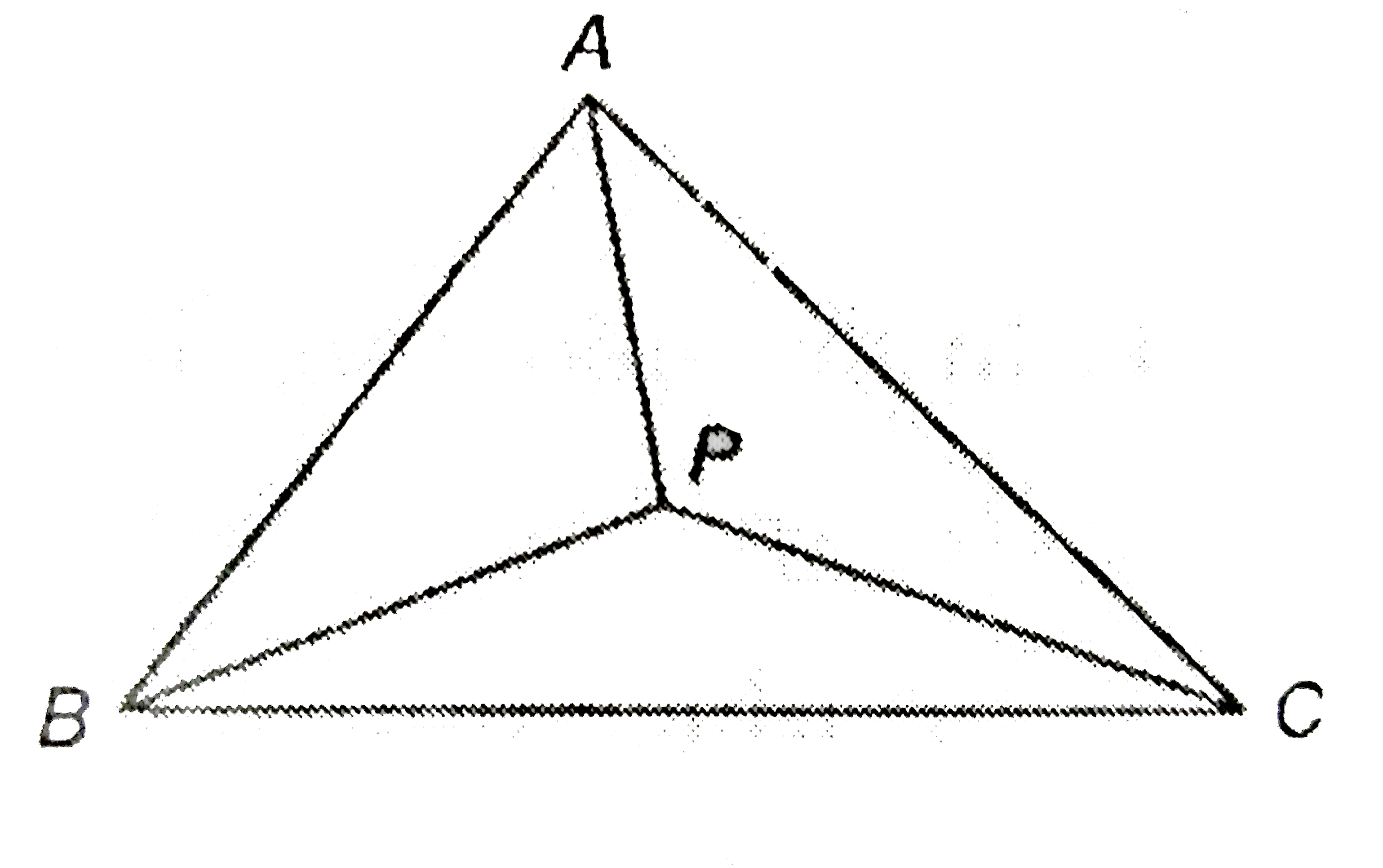A(3,4),B(0,0)andc(3,0) are vertices of ΔABC. If 'P' is the point inside the ΔABC, such that d(P,BC)≤ min. {d(P,AB),d(P,AC)}. Then the maximum of d(P,BC) is.(where d(P,BC) represent distance between PandBC).
1
1/2
2
none of these
To solve the problem, we need to find the maximum distance d(P,BC) where P is a point inside triangle ABC such that d(P,BC)≤min{d(P,AB),d(P,AC)}.
1. Identify the vertices of the triangle:
- The vertices are given as A(3,4), B(0,0), and C(3,0).
2. Determine the equations of the sides of the triangle:
- Line AB:
- The slope of line AB is 4−03−0=43.
- The equation of line AB can be written as:
y=43x
- Line AC:
- The slope of line AC is 4−03−3 which is undefined (vertical line).
- The equation of line AC is:
x=3
- Line BC:
- The slope of line BC is 0−03−0=0 (horizontal line).
- The equation of line BC is:
y=0
3. Understanding the distances:
- The distance d(P,BC) is simply the y-coordinate of point P since BC is on the line y=0.
- The distances d(P,AB) and d(P,AC) need to be calculated based on the coordinates of P(x,y).
4. Using the given condition:
- The condition states that:
d(P,BC)≤min{d(P,AB),d(P,AC)}
- This implies that the distance from point P to line BC must be less than or equal to the distances to the other two sides.
5. Finding the maximum distance d(P,BC):
- The maximum distance from P to line BC occurs when P is at the incenter of triangle ABC.
- The incenter is given by the formula:
Ix=aAx+bBx+cCxa+b+c,Iy=aAy+bBy+cCya+b+c
- Where a,b,c are the lengths of the sides opposite to vertices A,B,C respectively.
6. Calculating the lengths of the sides:
- a=BC=√(3−0)2+(0−0)2=3
- b=AC=√(3−3)2+(4−0)2=4
- c=AB=√(3−0)2+(4−0)2=5
7. Substituting into the incenter formula:
- The coordinates of the incenter I are:
Ix=3⋅3+4⋅0+5⋅33+4+5=9+0+1512=2
Iy=3⋅4+4⋅0+5⋅03+4+5=12+0+012=1
8. Conclusion:
- The maximum distance d(P,BC) is equal to the y-coordinate of the incenter, which is 1.
Final Answer:
The maximum of d(P,BC) is 1.
- The vertices are given as A(3,4), B(0,0), and C(3,0).
- Line AB:
- The slope of line AB is 4−03−0=43.
- The equation of line AB can be written as:
y=43x
- Line AC:
- The slope of line AC is 4−03−3 which is undefined (vertical line).
- The equation of line AC is:
x=3
- Line BC:
- The slope of line BC is 0−03−0=0 (horizontal line).
- The equation of line BC is:
y=0
- The distance d(P,BC) is simply the y-coordinate of point P since BC is on the line y=0.
- The distances d(P,AB) and d(P,AC) need to be calculated based on the coordinates of P(x,y).
- The condition states that:
d(P,BC)≤min{d(P,AB),d(P,AC)}
- This implies that the distance from point P to line BC must be less than or equal to the distances to the other two sides.
- The maximum distance from P to line BC occurs when P is at the incenter of triangle ABC.
- The incenter is given by the formula:
Ix=aAx+bBx+cCxa+b+c,Iy=aAy+bBy+cCya+b+c
- Where a,b,c are the lengths of the sides opposite to vertices A,B,C respectively.
- a=BC=√(3−0)2+(0−0)2=3
- b=AC=√(3−3)2+(4−0)2=4
- c=AB=√(3−0)2+(4−0)2=5
- The coordinates of the incenter I are:
Ix=3⋅3+4⋅0+5⋅33+4+5=9+0+1512=2
Iy=3⋅4+4⋅0+5⋅03+4+5=12+0+012=1
- The maximum distance d(P,BC) is equal to the y-coordinate of the incenter, which is 1.
The maximum of d(P,BC) is 1.
Topper's Solved these Questions
- STRAIGHT LINESBOOK - OBJECTIVE RD SHARMA ENGLISHCHAPTER - STRAIGHT LINESEXERCISE - Section-1 Solved MCQs (Example)
1 Videos
- STRAIGHT LINESBOOK - OBJECTIVE RD SHARMA ENGLISHCHAPTER - STRAIGHT LINESEXERCISE - SECTION - II (ASSERTION - REASON TYPE MCQs)
14 Videos
- STRAIGHT LINESBOOK - OBJECTIVE RD SHARMA ENGLISHCHAPTER - STRAIGHT LINESEXERCISE - ILLUSTRATION 18
1 Videos
- SETSBOOK - OBJECTIVE RD SHARMA ENGLISHCHAPTER - SETSEXERCISE - Chapter Test
30 Videos
Similar Questions
In ΔABC,D is any point on side BC. Prove that
AB+BC+CA>2AD
View SolutionConsider a rectangle ABCD formed by the points A=(0,0), B= (6, 0), C =(6, 4) and D =(0,4), P (x, y) is a moving interior point of the rectangle, moving in such a way that d(P,AB)≤min{d(P,BC),d(P,CD)andd(P,AD)} here d (P, AB), d (P, BC), d (P, CD) and d (P, AD) represent the distance of the point P from the sides AB, BC, CD and AD respectively. Area of the region representing all possible positions of the point P is equal to (a) 8 sq. units (b) 4 sq. units (c) 12 sq. units (d) 6 sq. units
View SolutionA(4,3),B(6,5)andC(5,−2) are the vertices of a ΔABC, if P is a point on BC such that BP:PC=2:3. Find the co-ordinates of P and then prove then ar (ΔABP):ar(ΔACP)=2:3.
View SolutionIn a ΔABC the bisector of angles BandC lie along the lines x=yandy=0. If A is (1,2), then √10d(A,BC) where d (A, BC)represents distance of point A from side BC
View SolutionLet O(0,0),A(2,0),andB(11√3) be the vertices of a triangle. Let R be the region consisting of all those points P inside OAB which satisfy d(P,OA)≤min[d(p,OB),d(P,AB)] , where d denotes the distance from the point to the corresponding line. Sketch the region R and find its area.
View SolutionIn Figure, if AB∣∣DC and P is the mid-point BD, prove that P is also the midpoint of AC
View SolutionIn the adjoining figure, P is an interior point of ΔABC. Then prove that :
AB+BC+CA<2(PA+PB+PC)

View SolutionConsider a ΔOAB formed by the point O(0,0),A(2,0),B(1,√3).P(x,y) is an arbitrary interior point of triangle moving in such a way that d(P,OA)+d(P,AB)+d(P,OB)=√3, where d(P,OA),d(P,AB),d(P,OB) represent the distance of P from the sides OA,AB and OB respectively
Area of region reperesenting all possible position of point P is equal to
View SolutionThe angles A, B and C of a ΔABC are in A.P. If AB=6,BC=7,then AC=
View SolutionIf A=(2,3), B=(-2-5), C=(-4,6) and if P is a point on BC such that AP bisects the angle A, then find P.
View Solution
